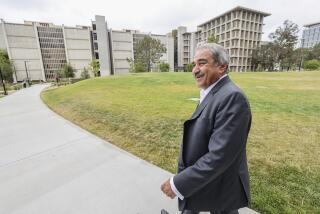UCSD Researchers Now Have a Bigger Eye on the Inner World
- Share via
San Diego scientists will unveil a powerful electron microscope today that could help them solve puzzles such as how to rejuvenate brain cells among Alzheimer’s patients and determine whether poor eyesight is formed in the womb.
The $1-million, 400,000-volt microscope, to be dedicated today at UC San Diego, will allow scientists to study tissue specimens 50 times thicker than those that can be studied with the standard 100,000-volt laboratory electron microscope.
UCSD is among the first five centers in the nation to use the microscope, which provides three-dimensional images, for biomedical research.
“This will be very important because it offers a way of observing the three-dimensional structures inside cells not previously available,” said Mark Ellisman, a professor of neurosciences at UCSD’s School of Medicine who has worked for almost 20 years honing the abilities of electron microscopes.
Ellisman is the director of the San Diego Microscopy and Imaging Research Resource in the medical school’s Basic Science Building. He and others say the new microscope promises to unlock doors previously closed to researchers.
Ellisman studies Alzheimer’s disease, which causes loss of memory, confusion and dementia. He and others have already learned that abnormal fibrous material appears in the brain cells of patients with Alzheimer’s.
Upon close examination, Ellisman realized that the fibrous material seemed to rearrange the inner components of these diseased cells--which might explain why
the cells no longer function properly.
“We are creating a gallery of images of sick cells and normal cells. We use the microscope image to magnify three-dimensional images of cells, rotate these images and view the cells’ internal components from different perspectives,” he said. “In this way, we can get a better picture of just how the fibrous material is affecting the brain cells of Alzheimer’s patients.”
The UCSD microscope will be made available free to qualified local researchers, including scientists from other institutions. To use the microscope, researchers must apply to a review panel.
Ellisman and other researchers have already started trying out the microscope. On Saturday, he and others will review techniques and procedures with a visiting national advisory panel. Beginning Monday, he said, they hope the microscope will be officially available for scheduled research projects.
So far, those projects include studying how babies’ brains are affected when their mothers take drugs and stimulants during pregnancy, determining whether poor eyesight develops during gestation and trying to rejuvenate dead or dying brain cells to develop treatments for Alzheimer’s and Parkinson’s disease.
When scientists study a cell, a specimen is sliced into thin sections, “just like slices of bread,” Ellisman said. But the sections are about a thousand times thinner than a single human hair. The slices are magnified under the microscope, and the image is either fed into a computer or printed on film. At that point, computers reassemble the sections, creating a three-dimensional, color picture of the cell.
“It is this spectacular image that is important to scientific study,” Ellisman said. “By analyzing each image, they could pinpoint minute differences between cells that might give clues into how the disease affects the cells.”
The microscope is funded by a 1988 $4-million grant from the National Institutes of Health, which also funded four other microscopes at centers in Berkeley, North Carolina, Texas and Pennsylvania. These facilities will be the first to use such a powerful microscope for biomedical research, said UCSD spokeswoman Denine Denlinger.
Of the five facilities, UCSD will be the only one to target the body’s nervous system, Ellisman said.
Across the nation, there are also several 1-million-volt microscopes, developed about 20 years ago. Although those are clearly more powerful, they are also far more costly to use and are considered obsolete by some researchers because they lack some modern attributes, such as the capacity to produce three-dimensional images, Denlinger said.






